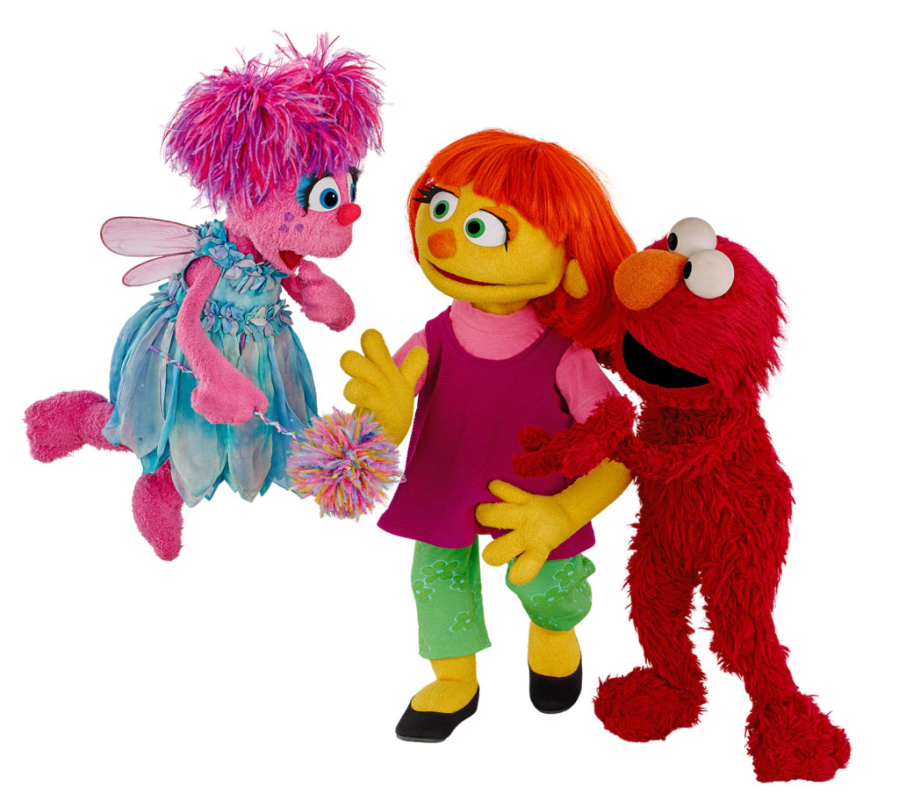Julia, the new Muppet who debuted Monday on Sesame Street, has a bright red mop of hair, a sunny yellow face and big green eyes. She is adorable and we are smitten by her laugh, her love of singing and her inventive game of Boing-Boing tag.
She also has autism, and the long-running show’s portrayal of the condition that affects 1 in 68 kids is sensitive and nuanced, a hint at the years of research that went into carefully crafting this lovely 4-year-old friend for Elmo, Abby Cadabby and the rest of the crew.
Years of research
A child watching might not notice the subtleties, such as how the other characters don’t ask Julia a lot of open-ended questions, but rather offer or choices or say things to elicit a reaction. Or that Julia sometimes repeats a question before answering. But as a parent of a child with autism, that quiet distinction stuck with me. It’s exactly what I’ve found works best in communicating with my son.
It’s no surprise that Sesame Workshop, which manages the show, gets so much right with Julia, given how long the show worked on her — they began looking into creating a character for the Sesame Street and Autism: See amazing in all children site and books about five years ago, according to Sherrie Westin, executive vice president for Global Impact and Philanthropy at Sesame Workshop. They consulted at least 14 organizations, including people with autism and those who work with them or have family members who are autistic, because they wanted to get as much input as possible.
“There are a lot of different opinions in the autism community and they’re not all aligned,” Westin said. “But this was not about a cause or a cure or any of the divisive issues. Everyone was willing to come together around the goals and objectives because it was about destigmatizing autism, and helping children feel like they’re not alone.”
And as cool as it is for children with autism to see themselves reflected in a Muppet, Julia has a lot to offer typically developing kids as well. When I told my kids (both of whom aged out of “Sesame Street” many years ago) about the new character, they were excited. But it was my daughter who had the strongest reaction. Essentially, she said, maybe now kids will finally get it, and how great would that be?
Two objectives
That was part of the goal, Westin said.
“We came away feeling like there were two objectives here,” Westin said. “One was to create a resource for families with autism, to make their day easier. The other was to destigmatize autism and address the community at large. We wanted to create greater understanding and awareness of what autism looks like — more understanding, more empathy and, ultimately, more inclusion.”
With that in mind, here are four things typical kids (and adults) can learn from watching Julia.
• How to interpret flapping and sensory issues. The short answer: Matter-of-factly. Julia’s Muppet friends acknowledge that she flaps her arms when she’s excited, that she prefers painting with a brush to using her fingers, and that she is particularly sensitive to loud noises such as sirens. Even though these gestures and sensitivities make Julia a bit different from her pals, they don’t set her apart in any meaningful way.
The characters explain to Big Bird that while a siren might not seem loud to him, it can be a painful sound for someone with heightened sensitivity to noises. They incorporate Julia’s bouncing into a game of tag, making it more fun for everyone. By treating these things as simply another part of who Julia is (and emphasizing that we’re all different in our own way), the Muppets teach kids to take it in stride.
• Autistic kids like (or dislike) a lot of the same things you do. Tag? Check. “Twinkle, Twinkle Little Star”? Check. Stuffed animals? That too. Elmo and friends find that Julia shares their interests, even if she sees the world through a different lens. The characterization helps kids find common ground with people with autism, while respectfully teaching about differences and how to honor them.
• People with autism don’t need to be fixed. Instead of trying to make Julia more like a typical person, or setting out to “fix” her, the Muppets meet her where she is and engage with her through play, the same way they would engage with any of their friends. There’s nothing wrong with her, after all, as Abby Cadabby says, “She does things just a little differently, in a Julia sort of way.”
• Just because she doesn’t respond in the way you expect, doesn’t mean you can’t be friends. Little kids are funny creatures, but they’re also perceptive and can be incredibly accepting of differences, once they understand them. Julia doesn’t look at Big Bird or Abby when they are talking to her, and she doesn’t always answer them right away. But the show is careful to point out that kids shouldn’t assume that she is rude or unfriendly or that she doesn’t like playing. In doing so, they debunk the stereotype that people with autism don’t need or want friends.
Julia is a joyful character who clearly enjoys her friends and their activities, and the Muppets model for kids how to reach out to people who don’t always respond in expected ways.
“Sometimes people with autism may do things that might seem confusing to you,” Alan tells Big Bird. “But you know what? Julia also does some things that you might want to try.”



